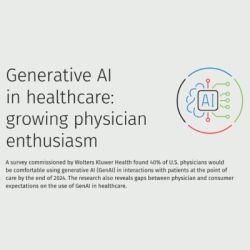Provider organisations have focused their attention on improving healthcare experiences of individual patients. Now, researchers say hospitals and clinics can leverage these individual healthcare experiences ("micro-level encounters") towards improving the health and wellbeing of the communities they serve.
A new study published in the Journal of Business Research has introduced the concept of Patient Ecosystem Management (PEM), which connects individual patient experiences to the community's health goals. Lead author Andrew S. Gallan, PhD, explains the main thrust of the study.
“This paper shows that two related concepts, intra-alignment (getting things in line within the provider-patient relationship) and inter-alignment (connecting the patient and her network to additional resources that address social determinants of health),” says Gallan, who works as assistant professor in the marketing department at Florida Atlantic University College of Business in Boca Raton, Florida.
The PEM model was developed to establish connections between micro-level interactions and a collective measure (community wellbeing). PEM will require new roles and behaviours, and leverage technology to expand and overlap patients' individual service ecosystems (intra-alignment), thus enlarging community wellbeing (inter-alignment), according to the study.
With the use of technology and online tools, patients will have easy access to helpful services that can aid in decision making, guide patients in healthy lifestyle changes, and answer a variety of health-related questions. In fact, the study includes a list of 14 sample organisations that have already taken steps to align patients with resources that can address specific issues beyond the walls of a hospital.
“Simply put, this concept provides a framework for healthcare organisations to follow to communicate with patients and their caregivers in such a way as to uncover any issues that function as obstacles to improved health and wellbeing; and, then, urges healthcare professionals to connect patients to resources that will expand the patient’s capabilities to reach their health goals,” Gallan points out.
In implementing PEM, he adds, hospitals can collaborate with existing organisations that are designed to help people in ways that improve the health and wellbeing of communities.
“Some healthcare organisations are partnering with legal services to help their patients address issues in their living situation that can create unhealthy environments (eg, mould causes exacerbations of asthma),” Gallan says.
As PEM adoption broadens, Gallan also envisions increased collaboration beyond clinical services by constructing as-needed networks of entities that come together to help individuals address obstacles to improved health and wellbeing.
Source: Managed Healthcare Executive
Image Credit: iStock
Latest Articles
Health, Community, Connecting Individual Health to the Community, individual health, micro-level encounters, Patient Ecosystem Management (PEM), Patient Ecosystem Management, PEM, Andrew S. Gallan, Journal of Business Research, Florida Atlantic University College of Business, PEM Model
A new study published in the Journal of Business Research has introduced the concept of Patient Ecosystem Management (PEM), which connects individual patient experiences to the community's health goals.


























